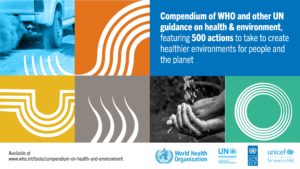Almost 25% of deaths worldwide could be prevented if the actions in the compendium were fully implemented
WHO, UNDP, UNEP and UNICEF have partnered to create a new compendium of 500 actions aimed at reducing death and diseases driven by environmental risk factors, the first such resource to unite this expertise from across the UN system.
Environmental pollution and other environmental risks cause 24 per cent of deaths through, for example, heart disease, stroke, poisonings, traffic accidents, and others. This toll could be substantially reduced – even eliminated – through bold preventive action at national, regional, local and sector-specific levels.
The Compendium of WHO and other UN guidance on health & environment provides easy access to practical actions for practitioners to scale up efforts to create healthy environments that prevent disease. It is designed for policymakers, staff in government ministries, local government, in-country UN personnel and other decision makers.
The repository presents actions and recommendations to address a comprehensive range of environmental risk factors to health, such as air pollution, unsafe water, sanitation, and hygiene, climate and ecosystem change, chemicals, radiation and occupational risks, among others.
Air pollution alone leads to 7 million deaths each year, while climate change is expected to contribute increasingly to a broad range of health impacts, both directly and indirectly through effects on biodiversity.
“Events like record-breaking high temperatures in North America, massive flooding in Europe and China, and devastating wildfire seasons provide increasingly frequent, grim reminders that countries need to step up action to eliminate the health impacts of environmental risk factors,” said Dr Maria Neira, Director, Department of Environment, Climate Change and Health, at WHO. “Implementing the actions in the compendium should be part of a healthy and green recovery from the COVID pandemic and beyond, and is essential to attaining the Sustainable Development Goals. The UN is uniting its health and environment expertise to support countries in this endeavour.”
The compendium, which is accessible via interactive webpages on the WHO website and as a PDF for offline reference, also addresses priority settings for action, such as cities and urban settlements, as well as cross-cutting topics like children’s environmental health.
“Young children are especially vulnerable to environmental risks, which can affect their survival and lifelong health and well-being,” said Aboubacar Kampo, Director of Health Programmes at UNICEF. “Healthy environments are a prerequisite for healthy children. Our assessment indicates that it can prevent a range of life-threatening diseases and quite significantly, up to a quarter of deaths among children under five years of age. Furthermore, healthy environments work as preventative health care and help reduce unnecessary medical costs for families, enabling them to invest in socio-economic progress.”
Young children are especially vulnerable to environmental risks.
Two thirds of deaths attributed to environmental risk factors are from non-communicable diseases (NCDs), such as heart disease, stroke and cancer, making the actions in the compendium a crucial part of addressing the NCD epidemic.
The compendium can also play an important role in achieving health equity, as low- and middle-income countries bear the greatest environmental burden in all types of diseases and injuries.

“The Compendium can be used to engage in country dialogue on development priorities in line with the 2030 Agenda, and to direct resources accordingly for resilient, healthy, inclusive and sustainable development,” said Dr Mandeep Dhaliwal, Director of the HIV, Health and Development Group at UNDP. “By addressing the factors that cause a large burden of the disease in low- and middle-income countries, the Compendium offers policymakers, the private sector and other stakeholders valuable tools for creating the transformative change needed to secure a healthy future for people and planet.”
“Channelling investments into the actions that address the triple planetary crises of climate change, biodiversity loss and pollution, which have profound implications for health, is key. We must transform the way we value nature if we are to safeguard health and achieve the Sustainable Development Goals — a major shift that requires multi-sector, multi-agency efforts. This compendium, by making available key tools and methodologies developed by a broad range of development partners is an important step in this direction and in promoting positive environment and health outcomes,” said Monika MacDevette, Chief, Chemicals and Health Branch, UNEP.
The compendium is a “living” repository, subject to updates and new guidance as they become available from partner organizations. Each action is briefly described and refers to the source for greater detail.
It calls for a scaling up of actions in countries by ministries of health and others at national, regional, local levels, with each of the outlined interventions classified according to principally involved sectors, level of implementation and necessary instruments, such as regulation, taxes and subsidies, infrastructure, education, communication, and others.
Find out more: Compendium of WHO and other UN guidance on health and environment
Hero photo © WHO / G. Lymperopoulos